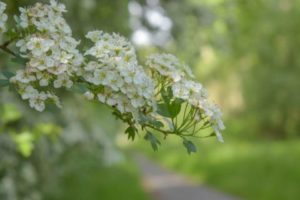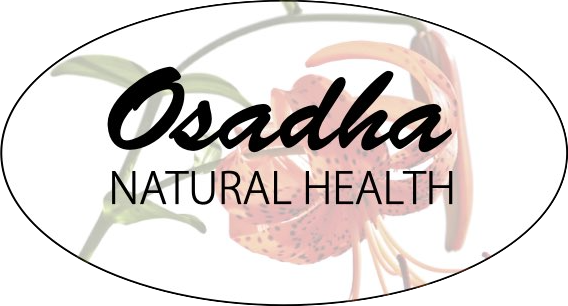The May Tree in the Celtic calendar, Hawthorn is the powerful grandmother of the Rose family and was thought in Europe to be the home of faeries. Haw means berry and thorn, well, that’s pretty self-explanatory. “Crataegus” derives from Greek….”kratos” means strength and “akis”, sharp. The thorns can be an inch long. Ouch!
thought in Europe to be the home of faeries. Haw means berry and thorn, well, that’s pretty self-explanatory. “Crataegus” derives from Greek….”kratos” means strength and “akis”, sharp. The thorns can be an inch long. Ouch!
Hawthorn may be found along rocky river edges, in damp canyons, and in thickets on meadow edges. We have some species around Durango that grow on drier slopes along runoff ditches and these tend to be smaller shrubs, while our river hawthorn range from large a shrub to actual tree. Hawthorn is easy to grow and is not hard to find at nurseries.
Hawthorn puts out beautiful, profuse clusters of not-so-great-smelling flowers in May, followed in the summer by bright red-to-reddish purple berries. The berries are perhaps more well known medicinally, but the freshly harvested and undamaged leaves and flowers, along with the twig ends and thorns are also great medicine and may even be stronger than the berries. I usually use them all together. The berries are used as tea, syrup or tincture. The unblemished leaves and flowers are best tinctured fresh. To this I add the thorns and twig ends. The berries are easy to find commercially and are thus most often used as medicine, but the leave and flowers may be stronger. I like to combine tinctures of all the parts.
1) Heart – physical
Hawthorn is one of my favorites. I’ve been taking it for several years due to a mild heart valve defect and resultant heart murmur. I used to get palpitations that could last 10 or more minutes and happened multiple times daily, especially if doing something physically intense or when stressed out. They’d also wake me up at night. Taking hawthorn as part of my daily tonic has greatly reduced the palpitations. When I’m off the herb for more than a week or so, the palpitations increase. Long term use of hawthorn had also changed the sound of my heartbeat. It’s now more of the typical “lub dub” sound instead of the “whoosh dub” sound that resulted from the leaky valve.
Indeed, Hawthorn is one of the premier cardiovascular tonics and has been used as such at least as far back as the ancient Greek herbalist, Dioscorides (1st century CE). It improves blood flow to and metabolism of heart muscle cells so that they beat more efficiently, helping a weak heart beat more strongly. With long term use, hawthorn can lower mild to moderate high blood pressure. This appears to be by at least three mechanisms: (i) Dilating peripheral blood vessels, (ii) acting as an ACE inhibitor and (iii) having mild diuretic activity.
The anti-oxidant flavonoids in hawthorn improve blood vessel integrity and function; providing support for capillary fragility and improving circulation to the heart itself. Hawthorn also supports the strength of the connective tissue around the blood vessels. Another way hawthorn helps with blood vessel health is by reducing cholesterol accumulation, possibly through anti-inflammatory effects, liver effects (liver controls cholesterol production, breakdown and elimination) and through mild cholesterol plaque-dissolving activity.
2) Heart – emotional/spiritual
At various times over the centuries, hawthorn has symbolized love, desire and fertility and then came to symbolize chastity and purity. The flowers were used at weddings in various parts of Europe as well as in Maypole ceremonies on May Day. In Robin Rose Bennet’s book, “Healing Magic”, she talks about using hawthorn for calling in a lover or for revitalizing a current relationship.
In Traditional Chinese Medicine, hawthorn is a Shen tonic. The Shen is our spirit — some say our consciousness — that resides in the heart and is expressed as compassion, kindness, wisdom and love. Accordingly, hawthorn has long been used not just for the physical heart but for the emotional or spirit heart. It is uplifting for a heavy heart and helps ease fear and anxiety. Ih herb school I was taught to use hawthorn for fear of death. Believe me, that’s useful when your heart rhythm’s going all over the place!
Like other members of the Rose family, hawthorn is used for a broken heart. Heartbreak is called that because, as everyone learns at one or more points in their lives, it actually hurts physically. Rose family members are used for heart opening after being shut down from an emotional wound. Hawthorn, with her large thorns, goes a step further in offering protection for a person, who despite their vulnerability, is venturing back out there again. When one’s heart is broken, it can damage how we see ourselves. Hawthorn can help by encouraging acceptance and bolstering self-love.
On top of all of this, hawthorn medicine tastes good! What’s not to love?
~~~
Content © Dr. Anna Marija Helt, Osadha Natural Health, LLC. Permission to republish any of the articles or videos in full or in part online or in print must be granted by the author in writing.
The articles and videos on this website for educational purposes only & have not been evaluated by the Food and Drug Administration. This information is not intended to diagnose, treat, cure, or prevent any disease or to substitute for advice from a licensed healthcare provider.
heart, cardiovascular, asthma, depression, anxiety, love
